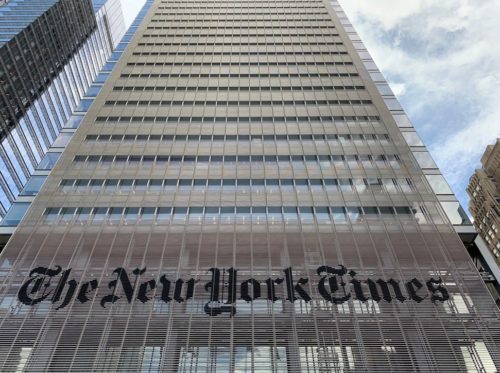
Photo provided courtesy of Unsplash.com
By David McPeak, Staff Writer
Will “fake news” eventually force the Supreme Court to revisit defamation law? The President thinks so—and Justice Thomas has recently reiterated his distaste for the current provisions under N.Y. Times Co. v. Sullivan. [1] Former Alaska Governor and 2008 Republican vice presidential candidate Sarah Palin also thinks so, as evidenced by her credible defamation claim against The New York Times. [2]
However unlikely this proposition is, the news media seems to be on thin ice. Several recent high-profile libel cases, including Palin’s, point to glaring deficiencies in the media’s good faith efforts to accurately report facts. This begs the question as to whether the media is currently a good steward of its immense privilege under the First Amendment.
Palin alleges that The Times falsely reported that she incited Jared Loughner’s 2011 shooting rampage which severely wounded Congresswoman Gabrielle Giffords, and killed six others. [3] The allegation was made subsequent to the 2017 shooting of Republican Congressman Steve Scalise by a Bernie Sanders supporter. [4] In the editorial titled “America’s Lethal Politics,” The Times alleged inter alia that in 2011, Palin’s Political Action Committee (“SarahPAC”) endorsed political violence by circulating a map “targeting” Democratic Congress members for their votes that passed the Affordable Care Act. [5] The editorial references “crosshairs” superimposed over each district, and falsely stated SarahPAC “targeted” individuals. [6] Palin also faults The Times for its subsequent correction which failed to mention her by name.
The media enjoys almost complete immunity from libel litigation when it comes to public figures. [7] This is because such figures invite public comment while also enjoying media access to counter false reporting. [8] More importantly, society has a genuine constitutional interest in the free discussion of their conduct. [9] To ensure the press has sufficient “breathing space” and to prevent “self-censorship,” the Supreme Court held in New York Times v. Sullivan, that such figures may only recover damages for defamatory falsehoods by clear and convincing proof of “actual malice,” rather than proof of falsity alone. [10] This rigorous fault standard requires that the defendant knew his statements were false, or acted in reckless disregard to the truth. [11] Put differently, plaintiffs have to prove fault based on the defendants state of mind, or conduct. [12]
Palin contends that the author had a “pre-determined argument he wanted to make in the editorial,” leading to the publishing of a statement “he either knew was false, or at least acted recklessly to whether it was false.” [13] Her theory is supported in the pleadings where the author James Bennet previously held editorial positions at The Atlantic and The New York Times, which both published numerous articles acknowledging Palin’s map had nothing to do with the Gifford’s shooting. [14]
The claim further argues Bennet had special reason to know the truth as his brother, United States Senator Michael Bennet from Colorado, received threats of gun violence at his Denver office two days prior to the Giffords shooting by a “schizophrenic constituent demanding assistance with government benefits.” [15] Palin claims this incident moved both brothers to advocate for gun control, and that her 2016 endorsement of Senator Bennet’s opponent, while Giffords endorsed Senator Bennet, further exhibits actual malice on Bennet’s part. [16]
The Second Circuit was unmoved—at least at the pleadings stage—by The Times’ argument proposing Bennet simply made an “unintended mistake” occasioned by a “research failure.” [17] Reversing dismissal as improper, the court held “at a minimum,” Palin plausibly pleaded Bennet had recklessly disregarded the truth by publishing the editorial without reviewing contrary articles he had published in The Atlantic as its editor. The court found further plausible inference in Palin’s allegations that “Bennet had reason to be personally biased against Palin and pro-gun positions in general.” [18]
The ability to have constructive dialogue when only 13% of U.S. adults trust the media “a fair amount” is unlikely. [19] The media’s self-inflicted credibility deficiencies are not wholly the result of alleged defamation, but Palin’s claim provides a rare opportunity to examine the veracity of statements made by news organizations under the sober reasoning of a Circuit Court opinion. The dismal amount of trust in the media suggests that public interest has tilted back towards more accountability, and that the media may have stretched beyond the “breathing space” accorded under N.Y. Times Co. v. Sullivan.
[1] Marcia Coyle, As SCOTUS Declines Cosby Defamation Case, Justice Thomas Urges Court to Revisit Landmark Ruling, Law.com (February 19, 2019 at 11:02 AM), https://www.law.com/therecorder/2019/02/19/justice-thomas-urges-court-to-revisit-landmark-defamation-ruling-403-30040/.
[2] Pl.’s Compl. at ¶ 1, Jun. 27, 2017, No. 1:17-cv-04853.
[3] Pl.’s Compl. at ¶ 1, Jun. 27, 2017, No. 1:17-cv-04853.
[4] Id. at ¶ 2.
[5] Palin v. N.Y. Times Co., 940 F.3d 804, at 808 (2d Cir. 2019).
[6] Id.
[7] N.Y. Times Co. v. Sullivan, 376 U.S. 254, 279 (1964)
[8] Curtis Pub. Co. v. Butts, 388 U.S. 130, 155 (1967)
[9] Id.
[10] N.Y. Times Co. v. Sullivan, 376 U.S. 254, 271-72 (1964)
[11] Id. at 280.
[12] Palin v. N.Y. Times Co., 940 F.3d 804, 810 (2d Cir. 2019)
[13] Id. at 813.
[14] Id.
[15] Pl.’s Am.Compl. at ¶ 4, Ex. 4, Aug 21 2017, 1:17-cv-04853-JSR.
[16] Palin, 940 F.3d at 814 (2d Cir. 2019).
[17] Id. at 817.
[18] Id.
[19] Paul Bedard, Just 13% trust media ‘a great deal,’ Democrats only majority with ‘confidence’
Washingtonexaminer.com (Sept. 26, 2019 08:16 AM), https://www.washingtonexaminer.com/washington-secrets/just-13-trust-media-a-great-deal-democrats-only-majority-with-confidence.